John Wayne Airport
John Wayne Airport (IATA: SNA[4], ICAO: KSNA, FAA LID: SNA)[5] is a commercial and general aviation airport that serves Orange County, California, and the Greater Los Angeles area. The airport is located in an unincorporated area of Orange County, and it is owned and operated by the county. John Wayne Airport is surrounded by the cities of Irvine, Newport Beach, and Costa Mesa, although its IATA airport code and mailing address are both registered to Santa Ana, the county seat. Originally named Orange County Airport, the Orange County Board of Supervisors renamed the airport in 1979 in honor of actor John Wayne, who lived in neighboring Newport Beach and died that year. A statue of John Wayne was installed at the airline terminal in 1982.[6]
John Wayne Airport | |||||||||||||||
|---|---|---|---|---|---|---|---|---|---|---|---|---|---|---|---|
 | |||||||||||||||
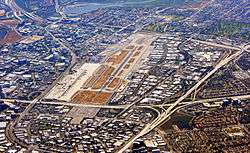 | |||||||||||||||
| Summary | |||||||||||||||
| Airport type | Public | ||||||||||||||
| Owner | Orange County | ||||||||||||||
| Operator | Orange County | ||||||||||||||
| Serves | Orange County | ||||||||||||||
| Location | 18601 Airport Way Santa Ana, California | ||||||||||||||
| Elevation AMSL | 56 ft / 17 m | ||||||||||||||
| Coordinates | 33°40′32″N 117°52′06″W | ||||||||||||||
| Website | www.OCair.com | ||||||||||||||
| Maps | |||||||||||||||
.jpg) FAA airport diagram | |||||||||||||||
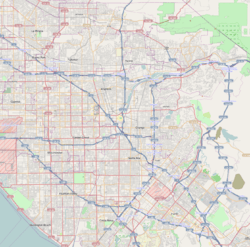 SNA Location of airport in Central Orange County 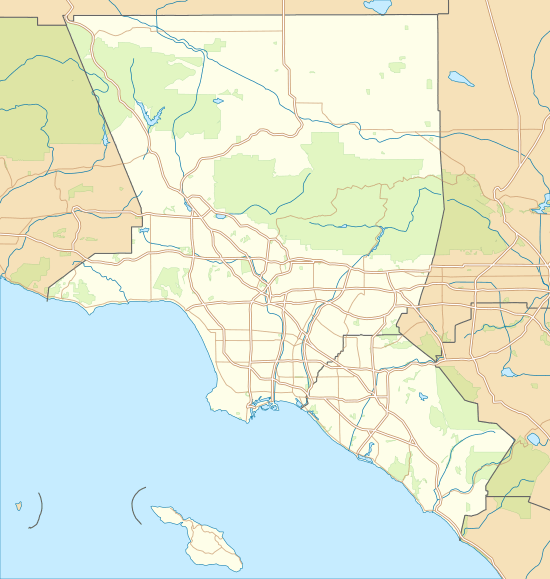 SNA SNA (the Los Angeles metropolitan area)  SNA SNA (California)  SNA SNA (the United States) | |||||||||||||||
| Runways | |||||||||||||||
| |||||||||||||||
| Statistics (2019) | |||||||||||||||
| |||||||||||||||
John Wayne Airport is the sole commercial airport in Orange County. The National Plan of Integrated Airport Systems for 2011–2015 categorized it as a primary commercial service airport since it has over 10,000 passenger boardings per year.[7] Federal Aviation Administration records say the airport had 4,584,147 enplanements in calendar year 2014, an increase from 4,450,628 in 2013.[8] In 2014, John Wayne Airport was the second busiest airport in the Greater Los Angeles area (by passenger count) with over 9 million total passengers.[9]As of 2015, the largest airlines at John Wayne Airport were Southwest Airlines, American Airlines, United Airlines, Alaska Airlines, and Delta Air Lines.[10]
In addition to the airline terminal, several facilities at the airport serve the general aviation and corporate aviation community. General aviation operations outnumber commercial operations. The only other general aviation airport in Orange County is Fullerton Municipal Airport.
John Wayne Airport has two runways. The main runway, 2L/20R, at 5,701 feet (1,738 m) in length, is one of the shortest of any major airport in the United States, and passenger airliners at the airport have never been larger than the Boeing 757 (though some larger cargo aircraft fly from SNA, such as the FedEx A300/310). Runway 2R/20L is 2,887 feet (880 m) long and serves general aviation aircraft. No wide-body passenger airliners have ever been scheduled at SNA.
History
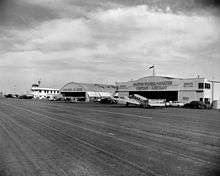
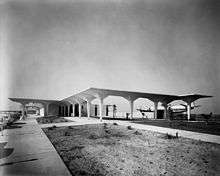
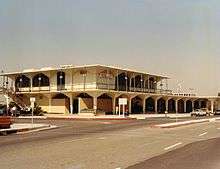
The first airstrip on the grounds was constructed in 1923, when Eddie Martin signed a five-year lease with James Irvine to operate a flying school on land owned by the Irvine Company.[11] It was purchased through a land swap by the County of Orange in 1939 and remains under the county's ownership and management.
Martin added the first hangar in 1926.[11] In 1935 Howard Hughes staged his world speed record-setting flight from the Eddie Martin Airport.
With the opening of the Santa Ana Army Air Base in 1942, the adjacent Martin Field was temporarily closed.[11]
After serving as a military base during World War II, the Santa Ana Army Airfield was returned by the federal government to the County with the stipulation that it remain open to all kinds of aviation uses.
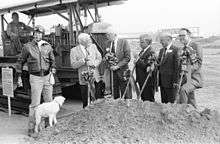
In addition to continuing to serve aviation, the field became an important drag racing center. From 1950 to 1959, C.J. "Pappy" Hart[12] and Creighton Hunter operated the Santa Ana Drag Strip, credited for being the world's first commercial drag strip,[13] on the airport runway every Sunday, when it was closed to air traffic.
The original single runway was 4,800 feet (1,500 m) long, on a magnetic heading of 210 degrees (Runway 21) and 30 degrees (Runway 3). In 1964 the airport was rebuilt, with its present two parallel runway configuration, oriented 190/10 degrees magnetic. The longer runway, 19R (now 20R), at 5,701 feet (1,738 m), is only 901 feet (275 m) longer than the old Runway 21 but long enough to accommodate jet airliners. A full instrument landing system (ILS) was also installed.
In the 1950s, the only airline flights were Bonanza's few flights between Los Angeles and Phoenix, via San Diego. In 1963 Bonanza started nonstop F27s to Phoenix, and to Las Vegas in 1965; in 1967 Air California started Electra nonstops to San Francisco, 48 flights a week each way. The first scheduled jet flights were Bonanza DC-9s later in 1967.
In 1967, the 22,000-square-foot (2,000 m2) Eddie Martin Terminal was built to accommodate 400,000 annual passengers. Remodeling added two passenger holding areas in 1974, a new baggage claim area in 1980 and a terminal annex building in 1982, bringing the facility to 29,000 square feet (2,700 m2).
Nonstop flights reached Salt Lake City in 1976–77 (Hughes DC9s), Denver in 1982 (Frontier MD80s), Dallas/Fort Worth in 1983 (American MD80s), Chicago in 1986 (AirCal 737-300s), and New York Kennedy in 1991 (America West 757s).
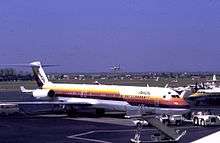
After the Orange County Airport was renamed John Wayne Airport on June 20, 1979,[14] the John Wayne Associates commissioned sculptor Robert Summers to create a bronze statue of "the Duke." The 9-foot (2.7 m) statue, created at Hoka Hey Foundry in Dublin, Texas, was dedicated to the County on November 4, 1982. Today, the bronze statue is in the Thomas F. Riley Terminal on the Arrival Level.
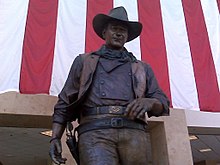
In 1990, the Thomas F. Riley Terminal opened. The aging 29,000-square-foot (2,700 m2) Eddie Martin Terminal was replaced with a modern 337,900-square-foot (31,390 m2) facility. The new facility included 14 loading bridges, four baggage carousels, wide open spaces and distinct roadside arrival and departure levels. In 1994, the then-unused Eddie Martin Terminal was demolished. In the late 1990s and early 2000s, a new, larger airport was proposed for the nearby site of the then recently closed El Toro Marine Corps Air Station. However, after a series of political battles, combined with significant opposition from residents in the vicinity of El Toro, the proposal was defeated, and no new airport was built.
In 2011, additional terminal space was added and existing terminals were refreshed as part of a $543 million expansion project.[15] A new Terminal C with six additional gates was built along with dedicated commuter gate areas in the new Terminal C and new commuter facilities in Terminal A. A new parking lot C was added along with additional support facilities such as a Central Utility plant.
In June 2020, a name change was requested, due to comments the actor made believed to be in support of white supremacy to Playboy in a 1971 interview.[16]
Terminals
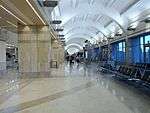
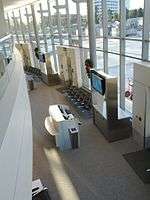
There are 22 gates in total. The main passenger terminal, the Thomas F. Riley Terminal, is named for the late county supervisor who lobbied for the airport's expansion in the 1980s. The Thomas F. Riley Terminal is divided into three terminal areas, A, B and C, with dedicated commuter gate areas at the north end of Terminal A and south end of Terminal C.
All three terminals, A, B and C, are within the same Thomas F. Riley building and security screened passengers can move "airside" between all terminal areas. Security screening lanes exist in all three terminals adjacent to check in. All security screening areas also have a "fast track" lane for first class and elite frequent fliers along with full TSA Pre Check availability based on TSA defined schedules. Switching between terminals indoors before security "landside" is also possible, the check in counter areas between all three terminals have connecting walkways to allow access between all terminals. Complimentary Wi-Fi is provided in all three terminals.
Terminals A and B
Terminals A and B were built in 1990 to replace the former Eddie Martin Terminal which was closed upon the new terminals' opening. In November 2011, Terminal A added a dedicated commuter gate area, along with refreshed gates, signage and information displays at both Terminals A and B.
Terminals A and B were designed by Gensler & Associates, Leason Pomeroy Associates, and Thompson Consultants International.[17] They contain restaurants, bars and shops, with a themed restaurant located in the air side connecting area of both terminals. In the upper rotunda above the themed restaurant is an American Airlines Admirals Club (operating out of Terminal A) and a United Club (operating out of Terminal B). Terminal A has gates 1–8, and Terminal B has gates 9–15.
Terminal C
Terminal C opened in November 2011 and added seven new gates, a dedicated commuter gate area and new eateries and retail.
Terminal C also provides a U.S. Customs and Border Protection FIS/Federal Inspection Service for international flights that do not have pre-clearance. Two arrival gates feed into the FIS and passengers once cleared exit at the south end of the Terminal C arrivals area. The FIS facility has Global Entry kiosks for registered users to shorten processing time. The FIS facility was designed by Gensler.[18] Terminal C has gates 16–22.
Arrivals level
The Arrivals level is on the lower level of the airport and provides seven baggage claim belts, two in Terminal A, two in Terminal B and three in Terminal C. Baggage Claim 7 is for international arrivals. Immediately outside the baggage claim is the curbside arrivals pickup area. Rental car offices are between Terminal A and B baggage claim areas with most rental agencies on site in the lower levels of the parking facility across the arrivals pickup area between Terminal A and B. Across the roadway from the arrivals pickup area between Terminal A and B is an island for public transportation, including taxis and buses.
International service
Alaska Airlines provided international service to Vancouver in 2002. However, a stop in Seattle (or change of planes) was required shortly after launch as John Wayne Airport was not authorized for pre-clearance or international flights by U.S. agencies.[19]
Canadian airline WestJet provides non-stop year round service to Vancouver (began May 2011). WestJet did provide seasonal service to Calgary, but this was cancelled in 2013.
Flights from Canada complete immigration and customs formalities in Canada via United States border preclearance.
Southwest Airlines subsidiary AirTran Airways began a new service in June 2012 from John Wayne Airport to Cabo San Lucas and Mexico City. This was the first international service to use the new FIS in Terminal C.[20] This service is now operated and branded by Southwest Airlines.
Mexico's Interjet began a new service in October 2012 from Orange County to Guadalajara and Mexico City.[21][22] It ended both flights in July 2014; the airport officials are seeking a replacement.[23]
Alaska Airlines began a Mexico service in October 2015. The airline began offering non-stop flights from John Wayne Airport to Los Cabos on October 8 and Puerto Vallarta on the following day, October 9. Alaska Airlines has continued this service to each airport on an every-other-day rotation.[24][25]
On March 3, 2020, it was announced that Canada's flag carrier, Air Canada will start new daily flights to Vancouver, British Columbia, Canada starting from September 8, 2020, marking its return to service to Orange County after 10 years.[26][27] It previously operated flights to Toronto, Ontario, Canada from April 8, 2010, becoming the first-ever international airline to serve Orange County, until it ceased flights later that year.[28][29] It is expected to compete with WestJet which also operates daily flights to Vancouver.
Aircraft noise abatement and curfew
A 1985 settlement agreement defined the scope of operation for John Wayne Airport in how it affects the local community. The area that lies directly south of John Wayne Airport is considered a noise sensitive area. The agreement in conjunction with a Phase 2 Commercial Airline Access Plan and Regulation controls the number of noisier operations (mainly commercial aircraft) allowed from the airport. Noise abatement enforcement is carried out with the aid of 10 permanent noise monitoring stations. These stations are placed in areas that exceed a community noise equivalent level (CNEL) of 65 dB.
The short primary runway (20R/2L), coupled with the local noise restrictions, can require a takeoff at or near full power (95–97% power). Some aircraft departing from the airport may cycle to full power while holding at the runway then release the brakes when engines are fully spooled up (shortfield procedure). On operations from runway 20R a steep climb may also be required to allow for a power reduction at about 500 to 700 feet (150–210 m) for a quieter overflight over the city of Newport Beach. For 20R departures, a left turn after departure to 175 degrees allows for a passage over Newport Beach within the confines of the noise abatement profile. Departures from 2L (normally during Santa Ana wind conditions) are not affected by these noise abatement procedures. Landings almost always include full flap extensions, and the use of full reverse thrust. Extension of the runway is almost impossible, as it on both ends is enclosed by motorways and, past the motorways, numerous residences and businesses which would require relocation in case of such a proposition, which is a costly endeavour.
The county prohibits commercial departures between 10:00PM and 7:00AM (8:00AM on Sundays) and commercial arrivals between 11:00PM and 7:00AM (8:00AM on Sundays). Exceptions can be made for an emergency, mechanical, air traffic control or weather delay, which is beyond the control of the airline.
In 2003, the settlement agreement was amended to increase operations, but focused on increases only for aircraft meeting the lowest noise signatures.
Access and noise reports are published by the airport and are available to the public. These reports are generated on a regular basis and outline curfew exceptions per carrier and overall noise impact.[30]
John Wayne Airport has been rated as one of the nation's scariest airports. In order to compensate for a short runway, and to comply with local noise restrictions, pilots frequently take off at an angle of 20 to 25 degrees, compared to 10 to 15 degrees at other airports.[31]
Airlines and destinations
Passenger
The following airlines offer scheduled passenger service. All international arrivals (excluding flights from destinations with U.S. border preclearance) are processed in Terminal C.
| Airlines | Destinations | Refs |
|---|---|---|
| Air Canada | Vancouver (begins September 8, 2020) | [26][27] |
| Alaska Airlines | Everett, Portland (OR), San Francisco, Santa Rosa, Seattle/Tacoma | [32] |
| American Airlines | Chicago–O'Hare, Dallas/Fort Worth, Phoenix–Sky Harbor | [33] |
| Delta Air Lines | Atlanta, Detroit, Minneapolis/St. Paul, Salt Lake City, Seattle/Tacoma | [34] |
| Delta Connection | Seattle/Tacoma Seasonal: Las Vegas | [34] |
| Frontier Airlines | Denver, Las Vegas | [35] |
| JSX | Las Vegas, Oakland, Phoenix–Sky Harbor Seasonal: Monterey, Mammoth Lakes | [36] |
| Southwest Airlines | Denver, Las Vegas, Nashville (begins November 2, 2020),[37] Oakland, Phoenix–Sky Harbor, Sacramento, San Jose (CA) Seasonal: Dallas–Love, Houston–Hobby | [38] |
| United Airlines | Chicago–O'Hare, Denver, Houston–Intercontinental, Newark, San Francisco | [39] |
| United Express | San Francisco | [39] |
| WestJet | Vancouver | [40] |
Cargo
| Airlines | Destinations |
|---|---|
| FedEx Express | Los Angeles, Memphis |
| UPS Airlines | Louisville, Ontario, Phoenix–Sky Harbor, Portland (OR) |
| Destinations map |
|---|
 Orange County Santa Rosa Atlanta Destinations from John Wayne Airport Red = Year-round destination Green = Seasonal destination Black = Cargo destination Orange = Cargo & passenger destination |
Runways
John Wayne Airport covers 504 acres (2.04 km2).[1] The airport has multiple general aviation facilities, an airline concourse building split into three terminal areas, and 2 paved runways.
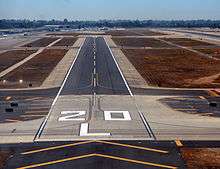
- Runway 2L/20R: 5,701 by 150 feet (1,738 m × 46 m), used by commercial aircraft and general aviation serving most incoming and departing traffic to the west of the airport. This runway is ILS equipped.
- Runway 2R/20L: 2,887 by 75 feet (880 m × 23 m), used by smaller general aviation aircraft and light aircraft.
General aviation
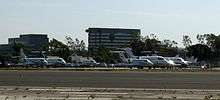
The airport is the home base for approximately 450 general aviation aircraft.[41][42]
The General Aviation Master Plan adopted in the early 1990s limits the number of FBOs (Fixed-base operator) at John Wayne Airport to two, currently Atlantic Aviation and ACI Jet. In addition to supporting fuel sales and other aircraft services, these companies lease facilities to flight training, charter, and aircraft maintenance businesses.
- FBOs:
- Atlantic Aviation
- ACI Jet
- Airport businesses
- Clay Lacy Aviation
- Martin Aviation Aircraft Maintenance
- HeliStream
- OC Helicopters
- Orange County Flight Center
- Regency Air
- Sunrise Aviation
- Western Avionics
Statistics
Top destinations
| Rank | City | Passengers | Carriers |
|---|---|---|---|
| 1 | 397,000 | American, Southwest | |
| 2 | 377,000 | Alaska, Southwest | |
| 3 | 369,000 | Alaska, Delta | |
| 4 | 352,000 | Frontier, Southwest, United | |
| 5 | 332,000 | American | |
| 6 | 295,000 | Alaska, United | |
| 7 | 259,000 | American, United | |
| 8 | 241,000 | Delta, Southwest | |
| 9 | 218,000 | Southwest | |
| 10 | 188,000 | Southwest |
Airline market share
| Rank | Airline | Passengers | Share |
|---|---|---|---|
| 1 | Southwest Airlines | 3,927,000 | 38.03% |
| 2 | United Airlines | 1,626,000 | 15.74% |
| 3 | American Airlines | 1,625,000 | 15.74% |
| 4 | Alaska Airlines | 1,053,000 | 10.20% |
| 5 | Delta Air Lines | 1,041,000 | 10.08% |
Annual traffic
| Year | Passengers | Change | Year | Passengers | Change | Year | Passengers | Change | ||
|---|---|---|---|---|---|---|---|---|---|---|
| 1990 | 4,586,596 | -- | 2000 | 7,772,801 | 2010 | 8,663,452 | ||||
| 1991 | 5,345,284 | 2001 | 7,324,557 | 2011 | 8,609,008 | |||||
| 1992 | 5,672,603 | 2002 | 7,903,066 | 2012 | 8,857,944 | |||||
| 1993 | 6,141,981 | 2003 | 8,535,130 | 2013 | 9,232,789 | |||||
| 1994 | 6,773,977 | 2004 | 9,272,394 | 2014 | 9,386,033 | |||||
| 1995 | 7,159,154 | 2005 | 9,627,032 | 2015 | 10,180,258 | |||||
| 1996 | 7,307,750 | 2006 | 9,613,480 | 2016 | 10,496,511 | |||||
| 1997 | 7,718,415 | 2007 | 9,979,699 | 2017 | 10,423,578 | |||||
| 1998 | 7,460,179 | 2008 | 8,989,603 | 2018 | 10,664,038 | |||||
| 1999 | 7,470,415 | 2009 | 8,705,199 | 2019 | 10,656,986 |
Ground transportation
Roads and highways
John Wayne Airport is located next to the interchange between the 405 Freeway and MacArthur Boulevard. The airport is also near the 405's interchange with the 55 Freeway. Heading south on MacArthur Boulevard from the airport provides access to the 73 Toll Road.
Bus
The airport is served by Orange County Transportation Authority ("OCTA") route 76, which runs only on weekdays from 6 am to 6 pm.
Car rental
On-site car rentals are available in the basement level of the Parking A2/B2 garages. Off site car rental shuttles are available at the Ground Transportation Center.
Parking
The airport has four parking garages open in the main terminal area: A1, A2, B2 and C. Valet parking is available between at a drop off/pick up area Terminals A and B, and between Terminals B and C. An off-airport parking lot (Main Street Parking) is also available at 1512 Main Street in Irvine, with free shuttle service to the terminals.
Irvine iShuttle
The City of Irvine's iShuttle route A serves the airport and Tustin Metrolink station. The iShuttle service runs only during weekday rush hours.[46]
Taxis and private shuttles
Taxis and private shuttles are available from the Ground Transportation Center located outside the lower level between Terminal A and B.
Accidents and incidents
On February 17, 1981, Air California (AirCal) Flight 336 (a Boeing 737-200), with 105 passengers and five crew members, was flying from San Jose, to John Wayne Airport and crashed upon initiating a go-around. The crew was cleared for a visual approach to Runway 19R while the controller had cleared a smaller plane to take off from 19R. Upon realizing that the landing aircraft might overtake the departing one, the controller ordered the flight to go around and the other aircraft to abort its takeoff, which it did. The captain of the landing Air California aircraft delayed the go-around then initiated a gear up procedure before a positive rate of climb was achieved, causing the plane to stall. The 737 then banked left at low altitude causing the left wingtip to make contact with the runway. Then the nose came down, striking the ground, and the airplane spun around and skidded down the runway before coming to rest in the margin. A fire started, but the passengers and crew exited the plane. Of the passengers, four sustained serious injuries, and 29 suffered minor injuries. The aircraft, registered N468AC, was damaged beyond repair and was written off.[48]
On December 15, 1993, a chartered IAI Westwind business jet carrying two flightcrew members and three passengers (including Rich Snyder, president of In-N-Out Burger), crashed while on approach to John Wayne Airport. All five occupants were killed in the crash. The aircraft, which departed Brackett Field, 30 miles to the north in La Verne, followed a Boeing 757 for landing, became caught in the 757's wake turbulence, rolled into a deep descent, and crashed near the intersection of State Route 55 and Edinger Avenue. The crash investigation led to the FAA requirement for an adequate period between heavy aircraft and following light aircraft to allow wake turbulence to diminish.[49]
On June 30, 2017, a Cessna 310 twin-engine aircraft crashed short of a runway into a highway median on Interstate 405. The pilot made a mayday call shortly after taking off from John Wayne Airport and attempted to land after being cleared for emergency landing on runway 20R. Two people on board were injured in the crash.[50]
On August 5, 2018, a Cessna 414 scheduled to land at John Wayne Airport crashed into a Staples parking lot a few blocks north of the airport in nearby Santa Ana, killing at least five people.[51][52]
On January 26, 2020, a Sikorsky S-76B helicopter took off from John Wayne Airport at approximately 9:06 am PST carrying retired NBA basketball player Kobe Bryant along with his 13 year old daughter, and 7 others bound for Camarillo Airport for a basketball event in Thousand Oaks. En route, the helicopter crashed into a hillside in Calabasas south of U.S. Route 101, killing everyone onboard. The helicopter had been seen in distress under heavy fog, according to witnesses. The cause of the crash is currently under investigation.[53][54]
Law enforcement operations
Orange County Sheriff's Department
John Wayne Airport has been the main base for the Orange County Sheriff's Department since 1985 when the county's board of supervisors approved the purchase of two Hughes MD500E aircraft nicknamed "Duke I" and "Duke II" which is the famous nickname of the airport's namesake. It was decided to be more practical to have two deputies operate the helicopter rather than a deputy and a civilian. In 1998 the OC Sheriff's Department traded up for a new helicopter, the McDonnell Douglas MD600N. At this time the OCSD became the first law enforcement agency to operate the MD600N. These helicopters were faster, quieter, and safer.
Today the ASU, or Air Support Unit operates of fleet of American Eurocopters AS350B2 or "ASTAR" for short. The first arrived in March 2005 and the second in March 2006. More recently the department purchased a Bell UH-1 Huey for purposes of SAR, or search and rescue.[55]
Costa Mesa Police Department
The Costa Mesa Police Department operated an ASU out of John Wayne Airport for 41 years. The division was called "ABLE" for Airborne Law Enforcement. They finished servicing their community in 2012 with the last helicopter platform being three Eurocopter EC-120 "Eagles".
Lyon Air Museum
Lyon Air Museum, founded by Major General William Lyon in 2009, is located in a hangar on the west side of the airport. It focuses particularly on World War II military aircraft and vehicles. The museum hosts the Collings Foundation, an annual flight experience program, every spring, allowing the public the opportunity to fly in a historic Boeing B-17 Flying Fortress or Consolidated B-24 Liberator.[56] The air museum features a rotating selection of antique cars from General Lyon's personal collection every year for a limited time. Past features include a collection of the General's Duesenbergs and Packard collections.
References
- FAA Airport Master Record for SNA (Form 5010 PDF), effective April 26, 2018.
- "Airport Statistics". OCair.com. John Wayne Airport, Orange County. Archived from the original on May 18, 2016. Retrieved March 7, 2016. (see 2015 YTD)
- "Airport Airport Statistics". John Wayne Airport. January 2017. Archived from the original on January 28, 2017. Retrieved February 28, 2017.
- "IATA Airport Code Search (SNA: Santa Ana / John Wayne)". International Air Transport Association. Archived from the original on August 7, 2013. Retrieved December 27, 2012.
- "General Information". OCair.com. John Wayne Airport, Orange County. Archived from the original on January 2, 2013. Retrieved December 27, 2012.
- "John Wayne Statue". OCair.com. John Wayne Airport, Orange County. June 2009. Archived from the original on May 12, 2008.
- "2011–2015 NPIAS Report, Appendix A" (PDF). National Plan of Integrated Airport Systems. Federal Aviation Administration. October 4, 2010. Archived from the original (PDF, 2.03 MB) on September 27, 2012.
- "Enplanements for CY 2011" (PDF, 1.7 MB). CY 2014 Passenger Boardings at Commercial Service Airports. Federal Aviation Administration. September 22, 2015. Archived (PDF) from the original on October 6, 2015. Retrieved December 18, 2015.
- "2014 North American (ACI-NA) Top 50 airports (includes Passenger, Cargo and Movements) Retrieved December 18, 2015". Airport Council International. Archived from the original (XLS, 147KB) on November 1, 2013. Retrieved December 18, 2015.
- "DOT BTS Passenger Data from SNA". 1/15 to 9/15 Date search of SNA by each Airline (WN: 1,569,780, AA(+US) 528,435, UA 483,764, AS 384,842, DL, 283,186). DOT BTS. December 18, 2015. Archived from the original on December 3, 2017. Retrieved December 18, 2015.
- Abandoned & Little-Known Airfields: California: Central Orange County Archived August 6, 2013, at the Wayback Machine. Members.tripod.com. Retrieved on July 21, 2013.
- http://www.wediditforlove.com/cj-2.html Archived March 13, 2013, at the Wayback Machine | Pappy Hart
- http://theselvedgeyard.wordpress.com/2009/05/25/1950-1959-the-santa-ana-drag-strip-days-they-did-it-for-love/ Archived May 11, 2013, at the Wayback Machine | commercial drag strip,
- Hiltzik, Michael (February 21, 2019). "It's time to take John Wayne's name off the Orange County airport". Los Angeles Times. Archived from the original on February 23, 2019. Retrieved February 23, 2019.
- Milbourn, Mary Ann (November 10, 2012). "New services clicking, JWA seeking more users". The Orange County Register. p. Business 1. Archived from the original on November 13, 2012. Retrieved November 10, 2012.
- "California Democrats pass resolution calling for John Wayne Airport to be renamed". Fox News. June 27, 2020. Retrieved June 27, 2020.
- Whiteson, Leon (September 4, 1990). "John Wayne Airport: User Friendly: Riley Terminal Makes Getting On, Off Planes as Simple as Possible". Los Angeles Times. Archived from the original on February 3, 2012. Retrieved June 14, 2012.
- Nelson, Nicole (November–December 2011). "John Wayne Airport Adds Third Passenger Terminal". Airport Improvement Magazine. Archived from the original on October 7, 2014.
- "Nonstop now stops... here". Orange County Register. The Seattle Times. May 23, 2002. Archived from the original on September 4, 2014. Retrieved July 31, 2012.
- Owen, Bill (November 13, 2011). "Summer Surprises – Southwest and Airtran Schedules Now Open for Sale Through August 10, 2012". Southwest Airlines blog. Archived from the original on November 14, 2011.
- Warner, Gary A. (September 12, 2012). "Interjet gets county approval to operate from JWA". Orange County Register. Archived from the original on September 17, 2012. Retrieved September 13, 2012.
- Warner, Gary A. (September 7, 2012). "Mexican airline passes JWA noise test". Orange County Register. Archived from the original on September 9, 2012. Retrieved September 8, 2012.
- Ann Milbourn, Mary (June 13, 2014). "Interjet ends Mexico flights at John Wayne". The Orange County Register. Orange County Register. Archived from the original on June 16, 2014. Retrieved June 15, 2014.
- "Alaska Airlines - Ready, set, jet! See our newest routes... - Facebook". facebook.com. Retrieved February 24, 2017.
- MADANS, HANNAH (March 10, 2015). "Alaska Airlines wants to offer more flights to Mexico from John Wayne Airport". Orange County Register. Archived from the original on February 12, 2017. Retrieved February 24, 2017.
- "Air Canada to Launch Daily, Year-Round Flights from Vancouver to Orange County (Santa Ana), California". Air Canada. March 3, 2020. Retrieved March 3, 2020.
- "Route suspensions due to COVID-19". AirCanada. Retrieved May 7, 2020.
- Schott, Kristen (April 6, 2010). "Air Canada starts service at JWA Thursday". OC Metro. Archived from the original on September 15, 2012. Retrieved September 17, 2012.
- Warner, Gary (October 25, 2010). "Air Canada ending O.C. service". Orange County Register. Archived from the original on September 18, 2012. Retrieved September 17, 2012.
- "Quarterly Noise Abatement Reports". OCair.com. John Wayne Airport, Orange County. Archived from the original on August 23, 2007. Retrieved May 10, 2007.
- "Steep takeoffs land JWA on 'scariest airports' list". The Orange County Register. Archived from the original on May 26, 2013. Retrieved March 10, 2014.
- "Flight Timetable". Archived from the original on February 2, 2017. Retrieved January 29, 2017.
- "Flight schedules and notifications". Archived from the original on February 2, 2017. Retrieved January 7, 2017.
- "FLIGHT SCHEDULES". Archived from the original on June 21, 2015. Retrieved January 7, 2017.
- "Frontier". Archived from the original on September 12, 2017. Retrieved January 7, 2017.
- "JetSuiteX". Archived from the original on April 24, 2018. Retrieved June 12, 2018.
- "Southwest Airlines Extends Published Flight Schedule Through Jan. 4, 2021". Southwest Airlines. May 2020. Retrieved June 27, 2020.
- "Check Flight Schedules". Archived from the original on February 2, 2017. Retrieved August 4, 2018.
- "Timetable". Archived from the original on January 28, 2017. Retrieved January 7, 2017.
- "Flight schedules". Archived from the original on February 10, 2017. Retrieved February 26, 2017.
- http://www.ocair.com/generalaviation/ Archived May 2, 2013, at the Wayback Machine | General Aviation at SNA
- Davis, Hillary. "Pilots of small planes try to protect their place at John Wayne Airport". latimes.com. Archived from the original on May 22, 2019. Retrieved May 22, 2019.
- "RITA BTS Transtats". Bureau of Transportation Statistics. Retrieved August 17, 2020.
- "RITA BTS Transtats". Bureau of Transportation Statistics. June 2016. Archived from the original on April 27, 2014. Retrieved April 25, 2014.
- "JOHN WAYNE AIRPORT POSTS STATISTICS - John Wayne Airport, Orange County (SNA), Located in Southern California - official website". John Wayne Airport. March 2019. Archived from the original on November 14, 2017. Retrieved March 26, 2019.
- "Route Info". IrvineShuttle.net. City of Irvine. Archived from the original on May 17, 2008.
- "JOHN WAYNE AIRPORT APPROVES PERMITS FOR RIDESHARING COMPANIES UBER AND WINGZ TO BEGIN OPERATING AT THE AIRPORT - John Wayne Airport, Orange County (SNA), Located in Southern California - official website". John Wayne Airport. March 30, 2015. Archived from the original on January 2, 2017. Retrieved February 24, 2017.
- "Archived copy" (PDF). Archived (PDF) from the original on April 30, 2017. Retrieved August 6, 2018.CS1 maint: archived copy as title (link)
- "Incident Report – Israel Aircraft Industries LAX94FA073 – December 15, 1993". National Transportation Safety Board. 1993. Archived from the original on March 15, 2013. Retrieved December 24, 2011.
- "Two Hospitalized After Fiery Plane Crash on 405 Freeway". NBC Southern California. Archived from the original on June 30, 2017. Retrieved June 30, 2017.
- "5 killed when small plane crashes in Santa Ana parking lot near South Coast Plaza, police say". KABC-TV. Archived from the original on August 5, 2018. Retrieved August 5, 2018.
- "Flight history for aircraft - N727RP". Flightradar24. Archived from the original on August 6, 2018. Retrieved August 5, 2018.
- Barnes, Mike; Kilkenny, Katie (January 26, 2020). "Kobe Bryant, NBA Superstar and Oscar Winner, Dies in Helicopter Crash". The Hollywood Reporter. Promethus Global Media. Retrieved January 27, 2020.
- Cohen, Ben; Ailworth, Erin (January 27, 2020). "The Last Flight of Kobe Bryant's Life". The Wall Street Journal. New York: Dow Jones & Company, Inc. Retrieved January 28, 2020.
- "Orange County, California - Aviation Support Unit". Orange County Sheriff's Department. Archived from the original on September 27, 2016. Retrieved February 24, 2017.
- "The Collings Foundation – Wings of Freedom Tour". Archived from the original on July 4, 2013. Retrieved August 22, 2013.
External links
![]()
- Official John Wayne Airport website
- Orange County Sheriff's Department John Wayne Airport Police Services
- Aerial image as of March 2004 from USGS The National Map
- FAA Airport Diagram (PDF), effective August 13, 2020
- FAA Terminal Procedures for SNA, effective August 13, 2020
- Resources for this airport:
- AirNav airport information for KSNA
- ASN accident history for SNA
- FlightAware airport information and live flight tracker
- NOAA/NWS weather observations: current, past three days
- SkyVector aeronautical chart for KSNA
- FAA current SNA delay information
